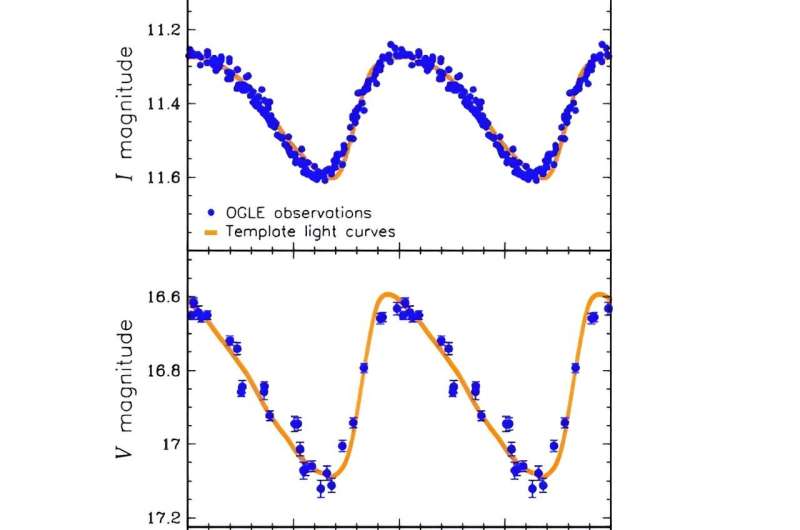April 8, 2024 report
This article has been reviewed according to Science X's editorial process and policies. Editors have highlighted the following attributes while ensuring the content's credibility:
fact-checked
preprint
trusted source
proofread
Astronomers discover the longest-period classical Cepheid in our galaxy

Astronomers from the University of Warsaw, Poland and elsewhere have detected a new classical Cepheid variable star. The newfound star, which received designation OGLE-GD-CEP-1884, has the longest pulsation period known among such variables in the Milky Way. The finding was detailed in a research paper published March 29 on the pre-print server arXiv.
Cepheid variables (or Cepheids) are luminous, yellow, horizontal branch stars changing their brightness with time as a result of regular stellar pulsations. Given that their periods of variation are closely related to their luminosity, astronomers use them to measure interstellar and intergalactic distances.
Classical Cepheids, also known as Population I Cepheids, undergo pulsations with very regular periods on the order of days to months. Given that their pulsation and stellar parameters are strictly connected, these variables are also used as a testbed for stellar evolution theories.
Now, a team of astronomers led by University of Warsaw's Igor Soszyński reports the finding of a new variable of that type. The new star, which has a relatively long pulsation period, was identified with the Warsaw Telescope at Las Campanas Observatory in Chile, as part of the Optical Gravitational Lensing Experiment (OGLE)—a long-term sky survey involving regular photometric observations of about two billion stars in our galaxy and in the Magellanic Clouds.
"We report the discovery of the classical Cepheid OGLE-GD-CEP-1884 (= GDS J1535467-555656) with the longest pulsation period known in our galaxy," the researchers wrote in the paper.
According to the study, OGLE-GD-CEP-1884 has a pulsation period of approximately 78.14 days—the longest known in Galactic classical Cepheids. The pulsation period of OGLE-GD-CEP-1884 is nearly 10 days longer than that of the second longest-period Cepheid in the Milky Way—S Vulpeculae.
OGLE-GD-CEP-1884 has a V-band magnitude of 16.83, mean radial velocity of -72.3 km/s and its age is estimated to be 22 million years. The astronomers noted that these parameters make this star likely the most luminous and youngest Galactic Cepheid. The distance to OGLE-GD-CEP-1884 was measured to be about 14,500 light years.
The astronomers noted that it is surprising that OGLE-GD-CEP-1884 has not been identified earlier as a long-period classical Cepheid given that it is quite a bright star in the sky, particularly at longer wavelengths. Therefore, they suppose that there might be more such Cepheids in the Milky Way that remain undetected.
"The discovery of OGLE-GD-CEP-1884 suggests that ULP Cepheids are also present in our galaxy, probably in the regions strongly affected by interstellar extinction. This finding underscores the need for current and future sky surveys to adopt more efficient methods of detecting and classifying variable stars," the authors of the paper conclude.
More information: Soszyński et al, Discovery of the Longest-Period Classical Cepheid in the Milky Way, arXiv (2024). DOI: 10.48550/arxiv.2404.00151
Journal information: arXiv
© 2024 Science X Network





















